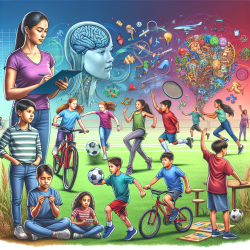Introduction
In the realm of speech-language pathology, the integration of stress-reduction techniques can significantly enhance therapeutic outcomes, especially for adolescents who are often subjected to high levels of stress. A recent study titled "Effects of Group-delivered Stress-reduction Guided Imagery on Salivary Cortisol, Salivary Amylase, and Stress Mood in Urban, Predominantly Latino Adolescents" provides valuable insights into how guided imagery can be effectively utilized in group settings to reduce stress biomarkers and improve mood states.
Understanding the Study
The study involved 111 predominantly Latino adolescents, divided into two groups: one receiving lifestyle education and the other receiving lifestyle education plus stress-reduction guided imagery (GI). The results were compelling, showing a 32% reduction in salivary cortisol levels in the GI group compared to a 5% reduction in the lifestyle-only group. This significant decrease in cortisol, a stress biomarker, suggests that guided imagery can be a potent tool for stress management in adolescents.
Key Findings and Implications
- Reduction in Stress Biomarkers: The guided imagery sessions led to a notable decrease in salivary cortisol, indicating reduced stress levels. This finding is crucial for practitioners as it highlights the physiological benefits of incorporating stress-reduction techniques into therapy.
- Improvement in Mood States: The GI group reported significant declines in stress mood states, with reductions ranging from 27% to 46% across various mood indicators. This improvement in self-reported mood states further supports the use of guided imagery as a therapeutic tool.
- Scalability of Group Interventions: Delivering guided imagery in a group format proved effective, making it a viable option for large-scale interventions in school settings. This approach can be particularly beneficial in resource-limited environments where individual therapy sessions may not be feasible.
Practical Applications for Practitioners
For speech-language pathologists and other practitioners working with adolescents, integrating guided imagery into therapy sessions can offer a dual benefit of enhancing communication skills while simultaneously reducing stress. Here are some practical steps to implement this approach:
- Incorporate Guided Imagery Scripts: Utilize pre-written scripts that focus on relaxation and stress reduction. Sessions can include relaxation breathing, progressive muscle relaxation, and visualization of a calming place.
- Facilitate Group Sessions: Conduct guided imagery in group settings to foster a sense of community and shared experience among participants. This approach not only reduces stress but also enhances group cohesion.
- Encourage Regular Practice: Motivate adolescents to practice guided imagery techniques at home to reinforce the stress-reduction benefits experienced during therapy sessions.
Encouraging Further Research
While the study provides promising results, further research is necessary to explore the long-term effects of guided imagery on stress and other health outcomes. Practitioners are encouraged to contribute to this growing body of evidence by implementing guided imagery in diverse settings and documenting their findings.
To read the original research paper, please follow this link: Effects of Group-delivered Stress-reduction Guided Imagery on Salivary Cortisol, Salivary Amylase, and Stress Mood in Urban, Predominantly Latino Adolescents.










